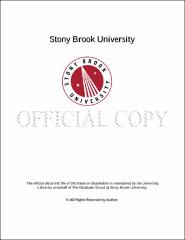| dc.identifier.uri | http://hdl.handle.net/11401/76704 | |
| dc.description.sponsorship | This work is sponsored by the Stony Brook University Graduate School in compliance with the requirements for completion of degree. | en_US |
| dc.format | Monograph | |
| dc.format.medium | Electronic Resource | en_US |
| dc.language.iso | en_US | |
| dc.publisher | The Graduate School, Stony Brook University: Stony Brook, NY. | |
| dc.type | Thesis | |
| dcterms.abstract | In his book, Francis Bacon: The Logic of Sensation, Gilles Deleuze betrays a preference for largely dramatic and "sensational" (even if not "sensationalistic") artworks that privilege the “scream†over the yawn, and ignores the type of understated works that Jacques Rancière would characterize as “pensive†images, or even the intentionally “boring†works of postmodern art. This paper critically examines Deleuzian concepts on the reception of art—i.e. sensation, affection, and affect—and explores their applicability to subtle and seemingly neutral/boring/deadpan works. Philosophers including Barthes and Rancière addressed the challenge of engaging with images in postmodernity by asking what happens when we encounter a yawn rather than a scream, or, in the case of Barthes, what happens when a scream makes us yawn? With the existence of already shocking photographs in mass culture, and with the end of the “shock of the new,†Barthes sought aesthetic redemption in the punctum rather than the studium. Heidegger, in The Fundamental Concepts of Metaphysics, looks at boredom itself as a "fundamental attunement" that needed to be absorbed and engaged with directly, rather than escaped from. Using Deleuze's example of "Pierre and Paul" in his lectures on Spinoza's concept of "affectio" (affection) and "affectus" (affect), this paper seeks to draw out some of the conceptual limitations in Deleuzian notions of sensation, affection, and affect in dealing with understated or purposely boring works, and proposes an understanding of these concepts in a less fixed and instantiated manner, and more as slower unravellings that grow, fade, or linger. | |
| dcterms.available | 2017-09-20T16:51:01Z | |
| dcterms.contributor | Belisle, Brooke. | en_US |
| dcterms.contributor | Casey, Edward S | en_US |
| dcterms.creator | Macagba, Jonathan Reyes | |
| dcterms.dateAccepted | 2017-09-20T16:51:01Z | |
| dcterms.dateSubmitted | 2017-09-20T16:51:01Z | |
| dcterms.description | Department of Art History and Criticism | en_US |
| dcterms.extent | 27 pg. | en_US |
| dcterms.format | Application/PDF | en_US |
| dcterms.format | Monograph | |
| dcterms.identifier | http://hdl.handle.net/11401/76704 | |
| dcterms.issued | 2017-05-01 | |
| dcterms.language | en_US | |
| dcterms.provenance | Made available in DSpace on 2017-09-20T16:51:01Z (GMT). No. of bitstreams: 1
Macagba_grad.sunysb_0771M_13234.pdf: 1177323 bytes, checksum: ec352167731a116076a23086f3cb34b2 (MD5)
Previous issue date: 1 | en |
| dcterms.publisher | The Graduate School, Stony Brook University: Stony Brook, NY. | |
| dcterms.subject | Art history -- Art criticism -- Aesthetics | |
| dcterms.subject | Affect, Boredom, Boring Art, Francis Bacon, Gilles Deleuze, Sensation | |
| dcterms.title | Boring Sensations: Deleuze on Meat and Vegetables | |
| dcterms.type | Thesis | |

